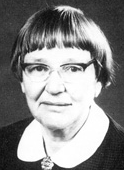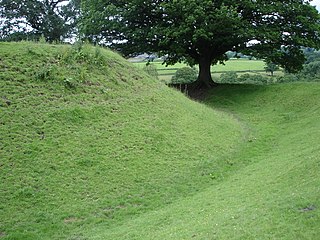
Dafydd ap Gwilym is regarded as one of the leading Welsh poets and amongst the great poets of Europe in the Middle Ages.

Rachel Bromwich born Rachel Sheldon Amos, was a British scholar. Her focus was on medieval Welsh literature, and she taught Celtic Languages and Literature in the Department of Anglo-Saxon, Norse and Celtic at the University of Cambridge, from 1945 to 1976. Among her most important contributions to the study of Welsh literature is Trioedd Ynys Prydein, her edition of the Welsh Triads.

"His Shadow" is a poem in the form of a cywydd by the 14th-century bard Dafydd ap Gwilym, widely considered the greatest of the Welsh poets. It relates a conversation in which the poet defends his character from the insinuations of his own shadow, and it parodies a popular medieval genre in which the Soul remonstrates with the Body. It has been argued that "His Shadow" was written towards the end of Daydd's poetic career. It was accepted in the 2007 edition of Dafydd ap Gwilym's poems by Dafydd Johnston et al. as a genuine work of his; previously, Thomas Parry had included it in his 1952 edition of Dafydd's works and in his Oxford Book of Welsh Verse (1962) as genuine, though in 1985 he expressed some doubts as to Dafydd's authorship.

"The Girls of Llanbadarn", or "The Ladies of Llanbadarn", is a short, wryly humorous poem by the 14th-century Welsh poet Dafydd ap Gwilym, in which he mocks his own lack of success with the girls of his neighbourhood. Dafydd is widely seen as the greatest of the Welsh poets, and this is one of his best-known works. The poem cannot be precisely dated, but was perhaps written in the 1340s.

"Trouble at a Tavern", or "Trouble at an Inn", is a short poem by the 14th-century Welsh poet Dafydd ap Gwilym, in which the poet comically narrates the mishaps which prevent him from keeping a midnight assignation with a girl. Dafydd is widely seen as the greatest of the Welsh poets, and this is one of his best-known poems. It has been described as "glorious farce", "one of Dafydd ap Gwilym's funniest and most celebrated cywyddau", and "the most vivid of [his] poems of incident".

"The Wind" is a 64-line love poem in the form of a cywydd by the 14th-century Welsh poet Dafydd ap Gwilym. Dafydd is widely seen as the greatest of the Welsh poets, and this is one of his most highly praised works. Rachel Bromwich called it "one of the greatest of all his poems", while the academic critic Andrew Breeze has hailed it as "a masterpiece" and "a work of genius", noting especially its "rhetorical splendour".

"Owain Glyndŵr's Court", also known as "Sycharth" or "The Court of Owain Glyndŵr at Sycharth", is a cywydd by the Welsh bard Iolo Goch. It describes and celebrates the hall and household of his patron, the nobleman Owain Glyndŵr, at Sycharth in Powys. It cannot be dated exactly, but was probably written about 1390, before Glyndŵr's revolt against the English crown. It survives in as many as 24 manuscripts.
"The Poet's Burial for Love" or "The Poet's Burial" is a Welsh-language love poem in the form of a cywydd in which the poet foresees his own death from unrequited love. It was formerly attributed to the 14th-century Welsh poet Dafydd ap Gwilym, but in 1952 was rejected from the canon of his works by Dafydd's editor, Thomas Parry and is now widely considered to be a 15th-century poem of uncertain authorship. The poem has nevertheless remained very popular with translators and it continues to appear in anthologies, including Thomas Parry's own Oxford Book of Welsh Verse.
"The Ruin" is a cywydd by the 14th-century Welsh poet Dafydd ap Gwilym, widely seen as the greatest of the Welsh poets. In it the poet, considering a ruined house and remembering the love-affair he once conducted there, reflects on the transience of all worldly pleasures. "The Ruin" is commonly supposed to have been written in Dafydd's old age. It has been called one of his most poignant poems, and it was included in The Penguin Book of Welsh Verse, The Oxford Book of Welsh Verse, The Oxford Book of Welsh Verse in English and The Longman Anthology of British Literature.
"The Poet and the Grey Friar" is a satirical poem in the form of a traethodl by the 14th-century Welsh poet Dafydd ap Gwilym, widely seen as the greatest of the Welsh-language poets. In it he relates an imaginary conversation with a Franciscan friar in which, rejecting the ascetic philosophy of the friar, he sets out a defence of love, poetry and the worldly life. It was included in The Oxford Book of Welsh Verse and The Penguin Book of Welsh Verse.
Gruffudd ap Maredudd ap Dafydd was a Welsh bard working in Anglesey in the service of the Tudors of Penmynydd. One of the last of the older school of poets known as the Gogynfeirdd, he resisted the innovations in Welsh verse-form which took place in his lifetime. About 2400 lines of his work have survived in the Red Book of Hergest. His best-known poem is "Gwenhwyfar", an elegy to a young lady. He was described by the literary historian D. Myrddin Lloyd as "the finest of all the late Gogynfeirdd poets" and by Saunders Lewis as "one of the greats".
"The Snow" is a 14th- or 15th-century Welsh-language poem in the form of a cywydd evoking a landscape which, to the poet's chagrin, is covered with snow. It has been described as an imaginative tour de force. Manuscripts of the poem mostly attribute it to Dafydd ap Gwilym, widely seen as the greatest of the Welsh poets, though some name Dafydd ab Edmwnd or Ieuan ap Rhys ap Llywelyn as the author. Modern literary historians have differed as to whether it is indeed by Dafydd ap Gwilym, but the two most recent editions of his poems have rejected it. The poem has nevertheless remained popular with translators and it continues to appear in anthologies, including Thomas Parry's own Oxford Book of Welsh Verse and Gwyn Jones's Oxford Book of Welsh Verse in English.

"The Woodland Mass" or "The Mass of the Grove" is a poem in the form of a cywydd by the 14th-century bard Dafydd ap Gwilym, widely seen as the greatest of the Welsh poets. It is one of his most popular works. Sometimes seen as blasphemous, it presents a woodland scene in which a thrush, sent by the poet's lover, and a nightingale officiate at a Mass celebrating both God and sexual love. "The Woodland Mass" is an example of a common type of medieval Welsh poem in which some bird or beast is used as a llatai or love-messenger, though this poem is unusual in that the message is sent to Dafydd rather than by him.

"The Mirror" is a poem in the form of a cywydd by the 14th-century bard Dafydd ap Gwilym, widely seen as the greatest of the Welsh poets. The poem describes how Dafydd, languishing with lovesickness for an unnamed Gwynedd woman, is appalled by the wasted appearance of his face in the mirror. "The Mirror" can be grouped with several other of Dafydd's poems, possibly early ones, set in Gwynedd, or alternatively with the many poems in which he expresses his love for a woman he calls Morfudd. It has been called "perhaps Dafydd's greatest masterpiece in the genre of self-deprecation".

"To the Yew Tree Above Dafydd ap Gwilym's Grave" is a 14th-century Welsh-language poem in the form of a cywydd, and is usually seen as either an elegy written after the death of Dafydd ap Gwilym or a mock-elegy addressed to him during his lifetime. Its author, Gruffudd Gryg, also wrote another elegy or mock-elegy on his friend Dafydd, and conducted a controversy in verse with him in which Dafydd's poems were criticised and defended. The cywydd on the yew tree constitutes the main evidence for the widespread belief that Dafydd is buried at Strata Florida Abbey in Ceredigion. It has been called "a superb poem, perhaps Gruffudd Gryg's best...a remarkably sensitive and perceptive act of poetic homage that acknowledges, far more than any more direct statement ever could, Dafydd's status as a true athro for his generation". It was included in both The Oxford Book of Welsh Verse and The Penguin Book of Welsh Verse.
"Gorhoffedd Hywel ab Owain Gwynedd", sometimes known in English as "Hywel's Boast", has historically been considered a poem by the mid-12th-century prince, warrior and poet Hywel ab Owain Gwynedd. However, some scholars now believe it to be two quite separate poems by Hywel which have become fused together in the process of manuscript transmission. It is his best-known work. In the first half the poet expresses his love of his native Gwynedd – its scenery, its men and women – and boasts of his own prowess in defending them; in the second he praises several Welsh ladies and tells us how many of them are sexual conquests of his. According to the writer Gwyn Williams, "The sharpness and clarity of the North Wales landscape has never been so well caught in words, nor have tenderness and humour been better mingled in the expression of love".
"Lament for Lleucu Llwyd" is a Middle Welsh poem by the 14th-century bard Llywelyn Goch ap Meurig Hen in the form of a cywydd. It is his most famous work, and has been called one of the finest of all cywyddau and one of the greatest of all Welsh-language love-poems, comparable with the best poems of Dafydd ap Gwilym. The culmination of a series of poems addressed to his lover Lleucu Llwyd, a married woman, it differs from them in calling her forth from her grave as if he were a more conventional lover serenading her as she lies in bed. The effect is said to be "startling, original, but in no way grotesque". "Lament for Lleucu Llwyd" was included in both The Oxford Book of Welsh Verse and The Oxford Book of Welsh Verse in English.
"Y Llafurwr", known in English as "The Ploughman" or "The Labourer", is a poem in the form of a cywydd by the 14th-century Welsh poet Iolo Goch. Often compared with William Langland's Middle English Piers Plowman, it presents a sympathetic portrayal of the meek and godly ploughman; no other Welsh bardic poem takes an ordinary working man as its subject. It has been called the most notable of Iolo's poems, comparable with the finest works of Dafydd ap Gwilym, and its popularity in the Middle Ages can be judged from the fact that it survives in seventy-five manuscripts. It is included in The Oxford Book of Welsh Verse.
Wiliam Llŷn was a Welsh-language poet whose work largely consists of elegies and praise-poems. He is considered the last major Welsh poet of the bardic tradition, comparable to the greatest late-medieval Welsh poets, and has been called Wales's supreme elegist. Two of his poems are included in The Oxford Book of Welsh Verse.
"The Maypole" or "To a Birch Tree", known in Welsh as "I'r fedwen", "Y fedwen yn bawl haf", or "Y fedwen las anfadwallt", is a cywydd by the mid-14th century bard Gruffudd ab Adda; it is one of only three poems of his that have survived. It was formerly attributed to the pre-eminent Welsh-language poet, Dafydd ap Gwilym. The poem presents the unhappy fate of a woodland birch tree which has been chopped down and re-erected in the town of Llanidloes as a maypole, then with pathetic irony asks the tree to choose between its former existence and its present one. Dancing round a maypole was a popular recreation in medieval Welsh towns, and this poem is the first record of it. "The Maypole" has been praised by literary historians as one of the very finest of Welsh cywyddau, and was included in The Oxford Book of Welsh Verse.








